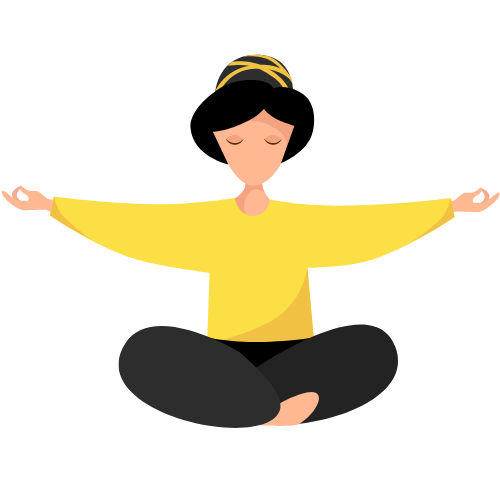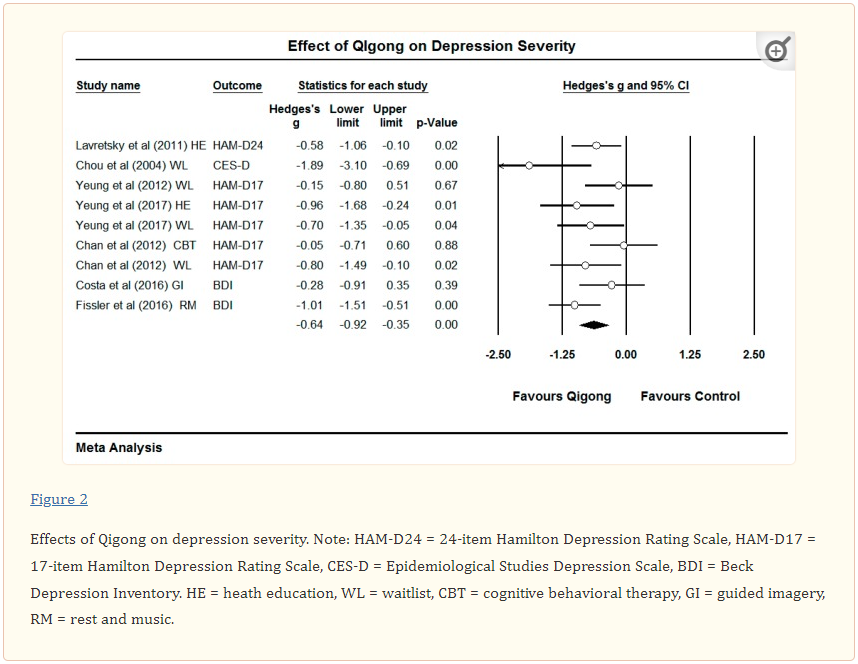
What is Qigong?
Qigong, also known as “chi kung” or “qi gong,” is a traditional Chinese practice that involves movement, meditation, and regulation of breath to improve the flow of qi, or life energy, in the body. The practice is said to have originated in China over 4,000 years ago and has been used for both medicinal and spiritual purposes.
Qigong is often described as a form of “energy medicine” because it is believed to enhance the body’s natural ability to heal itself. The movements and breathing techniques used in Qigong are said to help improve circulation and balance the flow of qi throughout the body. This, in turn, is thought to promote overall health and well-being.
In this article, we will cover everything you need to know about Qigong, including the different forms of Qigong therapy, how Qigong therapy works, the history of Qigong, the benefits and drawbacks of Qigong therapy, how therapists use Qigong, and the science behind it all.
Let’s jump right in and cover all of the different aspects of Qigong.
What are the different forms of Qigong?
There are two forms of Qigong therapy; passive and active. Passive Qigong therapy focuses on simple meditation while active Qigong therapy focuses on the flow of movements throughout the body. We will describe both types of Qigong therapy in this article.

Passive Qigong therapy:
As for passive Qigong therapy, there are two types; mental focusing (ru jing) and visualization (cun si).
Mental focusing (ru jing) therapy is just like a meditation practice where the patient closes their eyes, sits in an upright position, and tries to breathe in and out through their stomach. This type of Qigong therapy makes the patient truly focus on their breathing techniques, so that they can come to a balanced state of mind, relieving any type of stress or anxiety that may be flowing in their mind and body.
Visualization (cun si) therapy is very similar to mental focusing therapy, but it includes an aspect of imagination. A patient will normally close their eyes and the therapist will instruct them to imagine things that bring them happiness or joy, so that they could feel a sense of relaxation.
Active Qigong therapy:
As for active Qigong therapy, the flow of movement throughout the body is key. The therapist will instruct the patient to keep the body moving and flowing in a certain direction, enhancing the overall sensation of their mind and body.
Now, we will discuss the different ways in which Qigong therapy is utilized.
How does Qigong therapy work?
The practice of Qigong typically involves a series of slow, gentle movements that are performed with mindfulness and intention. These movements may be combined with deep breathing, visualization, and relaxation techniques to cultivate a sense of inner calm and balance. Some forms of Qigong may also incorporate elements of martial arts or meditation.
Today, there are many different styles and forms of Qigong, each with its own unique set of movements and techniques. Some of the most popular forms of Qigong include Tai Chi, Baduanjin, and Shaolin Qigong. Each of these forms has its own history and traditions, and continues to evolve and adapt to the needs of modern practitioners.

Some of the most popular forms of active Qigong include:
- Tai Chi: This is a slow, graceful form of Qigong that involves a series of slow, flowing movements that are performed in a specific sequence. The movements are often combined with deep breathing and meditation, and are said to promote relaxation and inner peace.
- Baduanjin: This is a form of Qigong that focuses on eight specific movements that are believed to improve circulation, reduce stress, and improve overall health. The movements are typically performed in a standing position and are designed to be gentle and easy to learn.
- Shaolin: This is a form of Qigong that originated in the Shaolin Temple in China and is known for its strong, flowing movements that are similar to those found in martial arts. Shaolin Qigong is believed to improve strength, flexibility, and balance.

In addition to its physical benefits, Qigong is also believed to have psychological and spiritual benefits. The practice of Qigong can help to reduce stress, improve mood, and promote a sense of inner peace and well-being. Some people also use Qigong as a form of spiritual practice, believing that the flow of qi can help to connect them with a higher power or universal energy.
Qigong is a powerful and versatile practice that has been used for centuries to improve health and well-being. Whether you’re looking to reduce stress, improve your physical health, or connect with your inner self, Qigong may be a great practice to try.
If you are looking for more information on Qigong, you have come to the right place. A consultation with Dr. Guita Balakhane can get you the answers you’re looking for. As a certified medical doctor who’s been in this space for over 30 years, Dr. Guita Balakhane has the expertise to assist you in your Qigong endeavors.
Now, let’s take a look at the history of Qigong and how it was born.
What is the history behind Qigong?
Qigong has its roots in traditional Chinese medicine and spirituality. The term “Qigong” is composed of two Chinese characters: “qi,” which refers to the life energy that flows through the body, and “gong,” which means “work” or “practice.” Therefore, the term “Qigong” can be translated as “working with qi” or “cultivating qi.” This is a very powerful phrase as it embodies a certain spirit that most people seek in their everyday lives; cultivating more energy and finding a deeper sense of healing.

Qigong is believed to have originated in China over 4,000 years ago and has been used for both medicinal and spiritual purposes. The earliest recorded use of Qigong can be traced back to the Yellow Emperor’s Classic of Internal Medicine, which is one of the foundational texts of traditional Chinese medicine. The text describes various Qigong techniques and their effects on the body, including the ability to improve circulation and balance the flow of qi.
Throughout Chinese history, Qigong has been used for a variety of purposes, including maintaining health and preventing illness, treating various ailments, and enhancing physical and mental performance. In the past, Qigong was often practiced by monks, shamans, and other spiritual practitioners as a means of achieving spiritual enlightenment and a deeper connection with the universe.
Now, let’s go over some of the benefits of Qigong in the next section.
What are the benefits of Qigong?
There are countless benefits of Qigong, mainly because it’s a form of meditation that can relax the mind, body and soul. People turn towards different forms of meditation because they can see and feel the difference it has made in their everyday lives. Doctors and professionals in the medical field unanimously agree that meditation is a great way to calm the mind, get in tune with your inner body, and even increase your level of spirituality.

Some of the main benefits of Qigong include:
- Improved circulation
- Reduced pain and inflammation
- Improved flexibility and range of motion
- Reduced stress and anxiety
- Improved mood and sleep
- Enhanced sense of well-being
- Increased energy levels
- Improved immune function
- Enhanced spiritual connection
In more recent times, Qigong has gained popularity as a form of physical exercise and stress reduction. The practice has been embraced by people of all ages and fitness levels, and is now taught in many schools, hospitals, and community centers around the world. This is a huge step towards the acceptance of Qigong in the medical field. The more Qigong is researched and practiced, the more people can truly see the benefits of it and how it could ultimately improve one’s life tremendously.

Despite its long history, Qigong remains a vibrant and relevant practice in the modern world. Whether it is used for its physical, psychological, or spiritual benefits, Qigong continues to be a powerful tool for promoting health and well-being.
If you happen to be looking for a Qigong practitioner, Dr. Guita Balakhane is a licensed medical doctor with over 30 years of experience in the field. She could assist you with your Qigong journey, whether you’re just starting out or happen to be a seasoned Qigong veteran.
In the next section, we will discuss some of the drawbacks of Qigong, if any.
What are the potential drawbacks of Qigong?
Qigong is considered to be generally safe. Because Qigong involves slow and gentle movements at the core, there are very few negative effects that could actually stem from practicing Qigong. But, as with anything, there are a few very minor negatives that should be stated so that you are fully aware of the intricacies of Qigong.
There are a few loose drawbacks to Qigong therapy. Some of them include:
- Unhealthy energy may flow throughout the body
- A loss of energy
- Energy flowing in the wrong pathway
- Blockages of energy that result from strange movements
- Confusion in the mind from the movements
- Dizziness
- Muscle twitching
- Soreness or weakness
- Delusions
These drawbacks aren’t a direct result of Qigong, but may stem from other areas, and subsequently, a Qigong therapy session may bring them to the forefront. It is extremely unlikely to experience these drawbacks during a Qigong session, and there certainly aren’t any direct links to these drawbacks solely from the practice of Qigong.
However, as with any form of physical activity, it is important to consult with a healthcare provider before starting Qigong therapy, especially if you have a pre-existing medical condition or are taking any medications. It is also important to work with a trained and experienced Qigong therapist to ensure that you are performing the movements correctly and safely.
Consulting with a trained professional is in your best favor when considering Qigong therapy. You may consult with Dr. Guita Balakhane, a trained medical doctor who’s been practicing Qigong for over three decades. She would be more than happy to help you on your Qigong adventures.
Now, in the next section, we will discuss the different ways in which therapists utilize Qigong.
How do therapists use Qigong?
Qigong therapy is a form of alternative medicine that involves the use of Qigong movements and techniques to promote health and well-being. Qigong therapy is typically performed by trained therapists who have experience in using Qigong to treat a variety of conditions.
Qigong therapists are trained to use various Qigong techniques to treat different conditions. For example, a therapist may use Qigong movements to improve circulation and reduce pain in a patient with arthritis. Or, a therapist may use Qigong breathing techniques to help a patient with anxiety or stress.

In addition to using Qigong movements and techniques, Qigong therapists may also use other forms of therapy, such as massage, acupuncture, or herbal medicine, to treat their patients. The specific approach used by a Qigong therapist will depend on the needs and preferences of the individual patient.
Qigong therapy is typically performed in a quiet, comfortable setting, such as a therapy room or clinic. The therapist will work with the patient to create a personalized treatment plan that is tailored to their specific needs and goals. The number and frequency of sessions will depend on the condition being treated and the individual’s response to the therapy.
If you are looking for a custom-tailored Qigong plan, you may consult Dr. Guita Balakhane. With over 30 years of experience in this industry, she can utilize her expertise and create a unique plan for your needs.
We will now dive into some research and see what the science says.
What does science say about Qigong therapy and what does the research show?
Many experiments have been conducted regarding the efficacy of Qigong therapy. One published research article in the National Library of Medicine (NIH) shows many interesting findings regarding Qigong therapy.
According to the National Library of Medicine (NIH), this specific experiment titled “Qigong-Based Therapy for Treating Adults with Major Depressive Disorder: A Meta-Analysis of Randomized Controlled Trials” conducted by Lijuan Guo, Zhaowei Kong, and Yanjie Zhang, had some promising results to report. The results showed that the Qigong intervention showed significant improvement in treatment response rate (OR = 4.38, 95% CI 1.26 to 15.23, p = 0.02) and remission rate (OR = 8.52, 95% CI 1.91 to 37.98, p = 0.005) compared with the waitlist control group.

Furthermore, the experiment states that, “In term of depression severity, the synthesized result indicated that Qigong therapy contributed to a more significant benefit than the control group (Hedges’ g = −0.64, 95% CI −0.92 to −0.35, p < 0. 001, I2 = 41.73%) (Figure 2).” It goes to show that Qigong therapy can truly help the lives of many people, especially if they are dealing with depression.
The experiment goes on to discuss even more positive results. It states, “Moreover, the effects of Qigong significantly reduced depression as compared to the active control group (Hedges’ g = −0.47, 95% CI −0.81 to −0.12, p = 0.01, I2 = 22.75%) and passive control group (Hedges’ g = −0.80, 95% CI −1.23 to −0.37, p < 0.01, I2 = 48.07%), respectively (Table 2).”

Lastly, the experiment makes a point to prove that the movement within Qigong exercises can significantly reduce depression in patients. It mentions that “The movement Qigong from seven sets of data had the benefit of significantly reducing depression (Hedges’ g = −0.62, 95% CI −0.96 to −0.28, p < 0.01, I2 = 41.62%).” The fact that Qigong therapy significantly reduced the level of depression in these clients is more of a reason to consider Qigong therapy for yourself. It definitely can’t hurt!
Even the research that has been conducted on Qigong therapy concludes that it is effective in treating some forms of depression. There are a slew of problems that Qigong therapy could assist with, as mentioned earlier in this article. Dr. Guita Balakhane is an avid believer of holistic medicine overall, which includes Qigong therapy at its core. Consider a consultation with Dr. Guita Balakhane to find out more.
Concluding Thoughts
Qigong therapy is a wonderful type of exercise and meditation practice that can truly improve the lives of many people who suffer from a range of different problems. It involves movement, meditation, and regulation of breath to improve the flow of energy throughout the mind, body, and soul. It was born as a type of traditional Chinese medicine over 4000 years ago and has been used for centuries by millions of people to help heal them of different blockages and pains.

If you or a loved one is looking to incorporate Qigong therapy, you may consider consulting with a trained medical professional. Dr. Guita Balakhane is a registered medical doctor who’s been in this field for over 30 years and has the expertise to assist you in many ways. Consider a consultation today.

